Digigram AUDIOWAY BRIDGE B2 Manuel utilisateur
- Catégorie
- Matériel musical
- Taper
- Manuel utilisateur
Ce manuel convient également à

User's Manual AUDIOWAY BRIDGE v1.0
AUDIOWAY BRIDGE
Smart gateway range between digital audio and
Dante / AES67 Audio-over-IP workflows
User’s manual
Valid for AUDIOWAY BRIDGE B1, B2 and B3
Valid with AVS-Monitor v5.11.30
February 2018

AUDIOWAY BRIDGE B1, B2, B3 USER’S MANUAL V1.0
User's Manual AUDIOWAY BRIDGE v1.0 Page 1/55
TABLE OF CONTENTS
1 IMPORTANT SAFETY INFORMATION ................................................................................................................. 3
2 INFORMATION FOR THE USER ........................................................................................................................... 5
2.1 FCC INFORMATION (U.S.A) .......................................................................................................................... 5
2.2 PRECAUTIONS................................................................................................................................................. 6
2.3 RACK MOUNTING ........................................................................................................................................... 6
2.4 LIMITATION OF LIABILITY ............................................................................................................................. 7
2.5 TRADEMARKS .................................................................................................................................................. 7
2.6 COPYRIGHT ...................................................................................................................................................... 7
2.7 PACKAGE CONTAINS .................................................................................................................................... 8
3 REQUIREMENTS ...................................................................................................................................................... 8
4 RELEASE NOTES ..................................................................................................................................................... 9
4.1 INITIAL VERSION ............................................................................................................................................. 9
5 THE AUDIOWAY BRIDGE RANGE ........................................................................................................................ 9
6 FRONT AND BACK PANELS ................................................................................................................................ 11
6.1 AUDIOWAY BRIDGE FRONT PANEL ........................................................................................................ 11
6.2 AUDIOWAY BRIDGE BACK PANEL ........................................................................................................... 12
7 PHYSICAL INTERFACES ...................................................................................................................................... 13
7.1 AUXILIARY POWER SUPPLY ..................................................................................................................... 13
7.2 GPI/O INTERFACE......................................................................................................................................... 14
7.3 AWc-DANTE INTERFACE ............................................................................................................................ 15
8.1 AWc-MADI INTERFACE (AUDIOWAY BRIDGE B1 and B2) .................................................................. 19
8.2 AWc-AES1616 INTERFACE (AUDIOWAY BRIDGE B1 and B3) ........................................................... 20
9 INSTALLATION AND CONFIGURATION WITH AVS-MONITOR ................................................................... 22
9.1 MAIN PANEL ................................................................................................................................................... 24
10 INTERNAL ROUTING MATRIX ......................................................................................................................... 29
10.1 FIRST SLOT, SECOND SLOT… ................................................................................................................ 29
10.2 ADVANCED MATRIX ROUTING.................................................................................................................. 29
11 AUDIOWAY BRIDGE REMOTE CONTROL WITH AVS-MONITOR ........................................................... 30
11.1 CLOCK SETUP ............................................................................................................................................... 30
11.2 AUDIO ROUTING ........................................................................................................................................... 32
11.3 REBOOTING AUDIOWAY BRIDGE ............................................................................................................ 33
11.4 SAMPLE RATE ............................................................................................................................................... 34
11.5 VU-METERS .................................................................................................................................................... 35
11.6 AWc-DANTE INTERFACE ............................................................................................................................ 36

AUDIOWAY BRIDGE B1, B2, B3 USER’S MANUAL V1.0
User's Manual AUDIOWAY BRIDGE v1.0 Page 2/55
11.7 AWc-MADI INTERFACE (AUDIOWAY BRIDGE B1 and B2) .................................................................. 45
11.8 AWc-AES1616 INTERFACE (AUDIOWAY BRIDGE B1 and B3) ........................................................... 47
12 FREQUENTLY ASKED QUESTIONS .............................................................................................................. 50
13 KNOWN ISSUES ................................................................................................................................................. 51
14 KEY FEATURES .................................................................................................................................................. 52

AUDIOWAY BRIDGE B1, B2, B3 USER’S MANUAL V1.0
User's Manual AUDIOWAY BRIDGE v1.0 Page 3/55
1 IMPORTANT SAFETY INFORMATION
Read carefully before using this equipment!
Follow these instructions and keep them in a safe place!
Keep in mind that damages due to failure to observe the instructions
contained in this manual are not covered by warranty.
Instructions importantes de sécurité Lire soigneusement
avant d’utiliser l’équipement!
Lisez et suivez ces instructions. Conservez les pour consultation
ultérieure! Les dommages dus au non-respect des instructions
contenues dans ce manuel ne sont pas couverts par la garantie.
Wichtige Sicherheitshinweise. Vor Inbetriebnahme des
Gerätes sorgfältig lesen!
Befolgen Sie die Anweisungen und bewahren Sie sie für spätere
Fragen auf! Bei Schäden, die durch Nichtbeachten dieser
Bedienungsanleitung verursacht werden, erlischt der
Garantieanspruch!
Throughout this manual, the
lightning bolt triangle is used
to alert the user to the risk of
electric shock.
The exclamation point triangle
is used to alert the user to
important operating or maintenance
instructions.

AUDIOWAY BRIDGE B1, B2, B3 USER’S MANUAL V1.0
User's Manual AUDIOWAY BRIDGE v1.0 Page 4/55
Do Not Open the Cabinet
There are no user-serviceable
components inside this product.
Opening the cabinet may present a shock
hazard, and any modification to the product will
void your warranty. If it is necessary to open the
device for maintenance or advanced
configuration purposes, this is to be done by
qualified personnel only after disconnecting the
power cord and network cables!
Power supply
The device is to be connected only to
a power supply as specified in this
manual and marked on the equipment.
This equipment must be earthed!
Do not block any of the ventilation openings!
Humidity
To reduce the risk of fire or shock, do not expose
this device to rain or moisture. Do not place
objects filled with liquid on this device.
Installation Location
To ensure proper operation and to avoid safety
hazards, the device must be installed in a 19“
rack mount chassis. The electrical installation of
the building should dispose of easily accessible
disconnecting means in the immediate vicinity of
the device.
If rack installation is not possible, place it on a
firm and level surface. The use of a supply lead
with a power plug respecting the legal standards
in the country of use is obligatory. The plug shall
be easily accessible in case of a problem.
Avoid installation in extremely hot or cold
locations, or in an area that is exposed to direct
sunlight or heating equipment. Avoid moist or
humid locations.
Connection of this product to an IT power supply
system is only in Norway.
Cleaning
Clean only with a soft, dry cloth. If necessary,
after disconnecting the unit’s cables, wipe it with
a soft cloth dampened with mild soapy water,
then with a fresh cloth with clean water. Wipe dry
immediately with a dry cloth. NEVER use
benzene, aerosol cleaners, thinner, alcohol or
any other volatile cleaning agent. Do not use
abrasive cleaners, which may damage the finish
of metal or other parts.
Refer all servicing to qualified service
personnel.
Servicing is required when the apparatus has
been damaged in any way, such as power supply
cord or plug is damaged, liquid has been spilled,
the apparatus has been exposed to rain or
moisture, does not operate normally, or has been
dropped.
Moving the device
Before moving the unit, be certain to disconnect
any cables that connect with other components.
Ne pas ouvrir l’appareil
L’ouverture du coffret peut produire
un risque de choc électrique, et toute
modification du produit annule votre garantie. S’il
est nécessaire d’ouvrir l’appareil pour l’entretien
ou la configuration avancée, cela doit être fait par
du personnel qualifié, après avoir débranché le
cordon d’alimentation et les câbles réseaux !
Alimentation
Il est primordial de connecter
l’appareil à une alimentation
électrique telle que spécifiée dans ce
manuel d´utilisateur et sur le matériel même.
Cet équipement doit être raccordé à la terre !
N’obstruer aucune ouverture de ventilation !
Humidité
Afin de réduire les risques de feu ou de choc,
n’exposez pas cet appareil à la pluie ou
l’humidité. Ne placez pas d´objet contenant un
liquide sur l’appareil.
Installation, mise en place
Afin d’assurer le fonctionnement correct et de
minimiser les risques potentiels liés à la sécurité,
l’appareil doit être installé dans un châssis 19
pouces. Si cela ne vous est pas possible, placez-
le sur une surface solide et plane. Prévoir dans
l’installation électrique du bâtiment un dispositif
de sectionnement aisément accessible et à
proximité immédiate de l’appareil.
L’utilisation d’un câble d’alimentation avec une
fiche de prise de courant respectant les normes
en vigueur dans le pays d’utilisation est
obligatoire. De plus la fiche de prise de courant
doit être aisément accessible en cas de
problème.
Évitez une installation dans des endroits très
chauds ou très froids ainsi que dans des lieux
exposés directement au soleil. Évitez les lieux
présentant un excès d’humidité.
Le raccordement de ce produit à un régime
d’alimentation IT n’est possible qu’en Norvège.
Nettoyage
Nettoyez uniquement avec un chiffon doux et
sec. Si nécessaire, après avoir débranché le
cordon d´alimentation, essuyez-le avec un
chiffon doux humidifié avec de l´eau savonneuse
puis rincez le á l´aide d un chiffon propre et
d´eau claire.
Séchez-le immédiatement avec un chiffon sec.
N’utilisez JAMAIS d´essence, de nettoyants en
aérosols, d´alcool ou tout autre agent nettoyant
volatile. N’utilisez pas de produits nettoyants
abrasifs qui pourraient endommager les finitions
métalliques ou d´autres pièces.
Réparation
Lorsque l’appareil a été endommagé quelle
qu’en soit la cause ou qu’il ne fonctionne pas
normalement, toute réparation doit être effectuée
par du personnel qualifié. Avant de transporter
l´unité, assurez-vous d´avoir bien déconnecté le
cordon d’alimentation ainsi que tous les câbles la
reliant à d´autres appareils.
Gerät nicht öffnen
Öffnen des Geräts kann eine
Gefährdung durch Stromschlag und
Erlöschen der Garantie zur Folge haben.
Reparaturarbeiten und Änderungen der
Hardwarekonfiguration dürfen nur von
qualifiziertem Personal nach entfernen der
Strom- und Netzwerkkabel durchgeführt werden.
Stromversorgung
Das Gerät darf nur mit der in dieser
Bedienungsanleitung und auf dem
Gerät angegebenen
Stromversorgung betrieben werden.
Erdung ist zu gewährleisten!
Belüftungsschlitze nicht verdecken!
Wasser und Feuchtigkeit
Um Brand- oder Stromschlagrisiken zu
vermeiden, darf das Gerät nicht mit Feuchtigkeit
in Berührung kommen.
Aufbau des Geräts
Um den einwandfreien Betrieb zu gewährleisten
und Sicherheitsrisiken zu vermeiden, sollte das
Gerät in einem 19-Zoll Baugruppenrahmen
montiert werden. Die elektrische Installation des
Gebäudes sollte über einen leicht zugänglichen
Trennschalter in unmittelbarer Nähe des Geräts
verfügen Nur wenn die Installation im Rack nicht
möglich ist, stellen Sie das Gerät auf einen
festen, waagerechten Untergrund.Die
Verwendung eines Anschlußkabels und eines
Steckers, die die im Benutzungsland gültigen
Normen erfüllen, ist obligatorisch. Des weiteren
muß die Steckdose für einen eventuellen
Problemfall leicht zugänglich sein.
Meiden Sie Standorte in der Nähe von Wärme-
oder Feuchtigkeitsquellen sowie direkte
Sonneneinstrahlung.
Anschluß dieses Produktes an eine spezielle IT-
Stromversorgung ist nur in Norwegen genehmigt.
Reinigen des Geräts
Säubern Sie das Gerät nur mit einem weichen,
trockenen Tuch. Bei Bedarf verwenden Sie ein
mit mildem Seifenwasser befeuchtetes Tuch,
nachdem Sie die Netzanschlusskabel aus der
Steckdose gezogen haben, anschließend ein
weiches, mit klarem Wasser befeuchtetes Tuch.
Trocken Sie das Gerät sofort im Anschluß.
Keinesfalls Benzol, Verdünner oder sonstige
starke Lösungsmittel oder Scheuerreiniger
verwenden, da hierdurch das Gehäuse
beschädigt werden könnte.
Lassen Sie etwaige Reparaturen nur von
qualifizierten Fachleuten durchführen!
Sollten das Netzkabel oder der Netzstecker
beschädigt sein, oder sollte das Gerät selbst
beschädigt worden sein (z. B. durch Eindringen
von Feuchtigkeit durch Fall auf den Boden), oder
sollte es nicht ordnungsgemäß funktionieren
oder eine deutliche Funktionsabweichung
aufweisen, so ist es von qualifizierten Fachleuten
zu reparieren.

AUDIOWAY BRIDGE B1, B2, B3 USER’S MANUAL V1.0
User's Manual AUDIOWAY BRIDGE v1.0 Page 5/55
2 INFORMATION FOR THE USER
2.1 FCC INFORMATION (U.S.A)
This device complies with Part 15 of the FCC rules. Operation is subject to the following two conditions:
1. This device may not cause harmful interference.
2. This device must accept any interference received including interference that may cause undesired
operation.
NOTE: This product has been tested and found to comply with the limits for a Class B Digital device,
pursuant to Part 15 of the FCC Rules. These limits are designed to provide reasonable protection against
harmful interference in a residential environment. This equipment generates, uses and can radiate radio
frequency energy and, if not installed and used in accordance with the instructions, may cause harmful
interference to the operation of other radio communications. Compliance with FCC regulations does not
guarantee that interference will not occur in all installations.
If this product is found to be the source of interference, which can be determined by turning the unit “OFF”
and “ON”, please try to eliminate the problems by using one of the following measures:
Relocate either this product or the device that is being affected by the interference.
Utilize power outlets that are on different branch (circuit breaker or fuse) circuits or install AC line
filter(s).
In the case of radio or TV interference, relocate/reorient the antenna. If the antenna lead-in is 300
ohm ribbon lead, change the lead-in to co-axial type cable.
If these corrective measures do not produce satisfactory results, please contact the local retailer authorized
to distribute this type of product
IMPORTANT: When connecting this product to accessories and/or another product, use only high quality
shielded cables. Cable/s supplied with this product MUST be used.

AUDIOWAY BRIDGE B1, B2,
B3
2.2 PRECAUTIONS
WARNING
DOUBLE POLE / NEUTRAL
Always follow the basic precautions listed belo
electrical shock, short-
circuiting, damages, fire or other hazards.
These precautions include, but are not limited to, the following:
Do not apply excessive pressure on connectors or any othe
metallic sharp parts (pins) of the product.
This product is electrostatic sensitive; make sure you check this before touching or using it.
The disconnect devices of the
AUDIOWAY BRIDGE
supply (option) and the appliance inlet on the rear side of the unit. These must be easily reachable.
To prevent electric shock, unplug the unit before handling. The achievement of other operations not
mentio
ned in this document is prohibited. Repairs can be performed only by a technician trained and
qualified.
Each connection must be Safety Extra Low Voltage kind (SELV), and must stay inside buildings.
Always use a power cable with a plug according to the cur
FINLAND: "Laite on liitettävä suojamaadoitus
NORWAY
: "Apparatet må tilkoples jordet stikkontakt"
SWEDEN
: "Apparaten skall anslutas till jordat uttag"
2.3 RACK MOUNTING
This product is designed to be rack-
mounted. Be sure to observe following installation rules of this kind of
equipment:
Do not block the vents.
This device has ventilation holes on the both side to prevent the internal
temperature from becoming too high. Inadequate ve
damage to the device(s), or even fire.
Elevated Operating Ambient -
If installed in a closed or multi
temperature of the rack environment may be greater than r
be given to installing the equipment in an environment compatible with the maximum ambient
temperature specified by the manufacturer.
Reduced Air Flow -
Installation of the equipment in a rack should be such tha
required for safe operation of the equipment is not compromised.
In some cases, to be sure to ensure sufficient airflow, leave the rear and the front of the rack open, leave
sufficient space (>5cm) on each side of the rack, and le
Or it can be better to have appropriate fan kit in the multi
Mechanical Loading -
Mounting of the equipment in the rack should be such that a hazardous condition
is not achieved due to uneven mechanical loading.
B3
User's Manual AUDIOWAY BRIDGE v
FUSING
Always follow the basic precautions listed belo
w to avoid the possibility of serious injury or even death from
circuiting, damages, fire or other hazards.
These precautions include, but are not limited to, the following:
Do not apply excessive pressure on connectors or any othe
r part of the board. Do not touch the
metallic sharp parts (pins) of the product.
This product is electrostatic sensitive; make sure you check this before touching or using it.
AUDIOWAY BRIDGE
unit
are the appliance inlet of the auxiliary power
supply (option) and the appliance inlet on the rear side of the unit. These must be easily reachable.
To prevent electric shock, unplug the unit before handling. The achievement of other operations not
ned in this document is prohibited. Repairs can be performed only by a technician trained and
Each connection must be Safety Extra Low Voltage kind (SELV), and must stay inside buildings.
Always use a power cable with a plug according to the cur
rent standards in the country of use
FINLAND: "Laite on liitettävä suojamaadoitus
koskettimilla varustettuun pistorasiaan"
: "Apparatet må tilkoples jordet stikkontakt"
: "Apparaten skall anslutas till jordat uttag"
mounted. Be sure to observe following installation rules of this kind of
This device has ventilation holes on the both side to prevent the internal
temperature from becoming too high. Inadequate ve
ntilation can result in overheating, possibly causing
damage to the device(s), or even fire.
If installed in a closed or multi
-
unit rack assembly, the operating ambient
temperature of the rack environment may be greater than r
oom ambient. Therefore, consideration should
be given to installing the equipment in an environment compatible with the maximum ambient
temperature specified by the manufacturer.
Installation of the equipment in a rack should be such tha
t the amount of air flow
required for safe operation of the equipment is not compromised.
In some cases, to be sure to ensure sufficient airflow, leave the rear and the front of the rack open, leave
sufficient space (>5cm) on each side of the rack, and le
ave space above rack (>1cm).
Or it can be better to have appropriate fan kit in the multi
-unit rack
Mounting of the equipment in the rack should be such that a hazardous condition
is not achieved due to uneven mechanical loading.
USER’S MANUAL V1.0
User's Manual AUDIOWAY BRIDGE v
1.0 Page 6/55
w to avoid the possibility of serious injury or even death from
r part of the board. Do not touch the
This product is electrostatic sensitive; make sure you check this before touching or using it.
are the appliance inlet of the auxiliary power
supply (option) and the appliance inlet on the rear side of the unit. These must be easily reachable.
To prevent electric shock, unplug the unit before handling. The achievement of other operations not
ned in this document is prohibited. Repairs can be performed only by a technician trained and
Each connection must be Safety Extra Low Voltage kind (SELV), and must stay inside buildings.
rent standards in the country of use
koskettimilla varustettuun pistorasiaan"
mounted. Be sure to observe following installation rules of this kind of
This device has ventilation holes on the both side to prevent the internal
ntilation can result in overheating, possibly causing
unit rack assembly, the operating ambient
oom ambient. Therefore, consideration should
be given to installing the equipment in an environment compatible with the maximum ambient
t the amount of air flow
In some cases, to be sure to ensure sufficient airflow, leave the rear and the front of the rack open, leave
ave space above rack (>1cm).
Mounting of the equipment in the rack should be such that a hazardous condition

AUDIOWAY BRIDGE B1, B2, B3 USER’S MANUAL V1.0
User's Manual AUDIOWAY BRIDGE v1.0 Page 7/55
Circuit Overloading - Consideration should be given to the connection of the equipment to the supply
circuit and the effect that overloading of the circuits might have on over current protection and supply
wiring.
Appropriate consideration of equipment nameplate ratings should be used when addressing this concern.
Reliable Earthing - Reliable earthing of rack-mounted equipment should be maintained. Particular
attention should be given to supply connections other than direct connections to the branch circuit (e.g.
use of power strips).
2.4 LIMITATION OF LIABILITY
In no case and in no way, the provider of this Product (Digigram, the distributor or reseller, or any other party
acting as provider) shall be liable and sued to court for damage, either direct or indirect, caused by and to the
user of the board and which would result from an improper installation or misuse of the Product. “Misuse”
and “improper installation” mean installation and use not corresponding to the instructions of this manual.
Please note that graphics given in this manual (drawings and schemes) are only examples and shall not be
taken for a real vision of your own equipment configuration.
Digigram is constantly working on the improvement of the products. For that purpose, the products
functionalities are bound to change and be upgraded without notice. Please read carefully the User’s manual
as the new functionalities will be described therein.
2.5 TRADEMARKS
All trademarks listed in this manual are the exclusive property of their respective owners. They are respected
“as is” by Digigram. Any use of these trademarks must receive prior approval of their respective owners. For
any question, please contact the trademark’s owner directly.
2.6 COPYRIGHT
Copyright
2018 Digigram. All rights reserved.
No portion of this manual may be reproduced without prior written consent from Digigram. The copyright
protection claimed here includes photocopying, translation and/or reformatting of the information contained in
this manual.
While every effort has been made to ensure accuracy, Digigram is not responsible for errors, omissions or
typos, and reserves the right to make improvements or changes in the products and programs described
without notice.
AVS-MONITOR is a trademark of AUVITRAN. Dante is a trademark of Audinate. All other trademarks are
property of their respective holders.

AUDIOWAY BRIDGE B1, B2, B3 USER’S MANUAL V1.0
User's Manual AUDIOWAY BRIDGE v1.0 Page 8/55
2.7 PACKAGE CONTAINS
1 AUDIOWAY BRIDGE B1, B2 or B3 Rack Unit
1 Power Cord
1 Quick start information sheet
3 REQUIREMENTS
You have just acquired a Digigram AUDIOWAY BRIDGE rack unit and we congratulate you! We hope you
will enjoy using it.
AUDIOWAY BRIDGE is a range of smart gateway between MADI, AES/EBU legacy audio and synchronous
Audio-over-IP, providing allowing key operational features:
Version B1 : Route low latency audio and synchronize clocks between 64/64 MADI, 16/16 Mono
AES/EBU and 64/64 Dante or AES67 I/O channels
Version B2 : Route low latency audio and synchronize clocks between 64/64 MADI and 64/64 Dante
or AES67 I/O channels
Version B3 : Route low latency audio and synchronize clocks between 16/16 Mono AES/EBU and
64/64 Dante or AES67 I/O channels
Monitor low latency audio whatever the technology
Seamless studio management with AVS-Monitor, Dante controller and multiple presets
Perform 24/7 mission critical operation with dual AC/DC power supply and redundante Dante network
audio
Requirements
Whatever its version, all AUDIOWAY BRIDGE operational parameters and audio streaming are
managed through the AVS-MONITOR(r) PC application, downloadable from AUDIOWAY BRIDGE
support page of Digigram web site.
AVS-MONITOR runs on Windows 10 / 8 / Seven / Vista, 32 or 64 bit.
To connect Dante equipments, you will also need to download the Dante controller from Audinate’s
web site.
Install AVS MONITOR (From version 5.11.30) and Dante controller on your control PC, which should
be installed on the same LAN as your AUDIOWAY BRIDGE B1 equipment
The manual at hand will guide through installation, configuration, and operation. You will find herewith the
necessary instructions to use your product. Please read them carefully as misuse of this device might cause
serious damage to you and your environment.
For any control and routing software related issue, please refer to the specific documentation of AUVITRAN’s
AVS-Monitor and Audinate’s Dante controller.

AUDIOWAY BRIDGE B1, B2, B3 USER’S MANUAL V1.0
User's Manual AUDIOWAY BRIDGE v1.0 Page 9/55
4 RELEASE NOTES
4.1 INITIAL VERSION
Creation of AUDIOWAY BRIDGE manual for versions B1, B2 and B3.
5 THE AUDIOWAY BRIDGE RANGE
To date of this manual, the AUDIOWAY BRIDGE range includes the 3 following products, each of them
equipped with a different configuration of interface modules
AUDIOWAY BRIDGE B1 is equipped with the following list of modules:
Name of the
product
Name of the card or module
Function of the card or module
AUDIOWAY
BRIDGE B1
AW-CORE
DIGIGRAM AUDIOWAY core
AWc-DANTE
AUDIOWAY DANTE card
AWc-MADI
AUDIOWAY MADI card
AWc-AES1616
AUDIOWAY AES/EBU 16/16 I/O card
AUDIOWAY BRIDGE B2 is equipped with the following list of modules:
Name of the
product
Name of the card or module
Function of the card or module
AUDIOWAY
BRIDGE B2
AW-CORE
DIGIGRAM AUDIOWAY core
AWc-DANTE
AUDIOWAY DANTE card
AWc-MADI
AUDIOWAY MADI card
AUDIOWAY BRIDGE B3 is equipped with the following list of modules:
Name of the
product
Name of the card or module
Function of the card or module
AUDIOWAY
BRIDGE B3
AW-CORE
DIGIGRAM AUDIOWAY core
AWc-DANTE
AUDIOWAY DANTE card

AUDIOWAY BRIDGE B1, B2, B3 USER’S MANUAL V1.0
User's Manual AUDIOWAY BRIDGE v1.0 Page 10/55
AWc-AES1616
AUDIOWAY AES/EBU 16/16 I/O card

AUDIOWAY BRIDGE B1, B2, B3 USER’S MANUAL V1.0
User's Manual AUDIOWAY BRIDGE v1.0 Page 11/55
6 FRONT AND BACK PANELS
6.1 AUDIOWAY BRIDGE FRONT PANEL
Reset
Front control panel displays quick information on the device status without the need to launch any software.
LED activity meaning:
Event: reflects Core or slot event.
Activity: reflects core activity, network activity or audio signal presence
Fault: Default found on AUDIOWAY BRIDGE
Error: Malfunction detected
Ready: AUDIOWAY BRIDGE is ready to be used
Power: Power supply is OK
Main: Main power supply present
Aux: Auxiliary power supply present
A Reset button (1) is also available to be used with a paper clip. Two functions can be obtained through
pressing this button:
Reset AUDIOWAY BRIDGE: press button for two seconds. Device will restart as if powered on.
Revert to Factory default: while powered off, press button and power on the device. Continue
pressing button until all panel LED are lighted. Both AUDIOWAY BRIDGE and all slots will then
reverted to their factory default values.
Note: Use “Revert to Factory” function with care as it will reset all AUDIOWAY BRIDGE and slot parameters,
and might lead to strange behavior on the network used.
The front panel of AUDIOWAY BRIDGE B1,B2 and B3 are identical

AUDIOWAY BRIDGE B1, B2, B3 USER’S MANUAL V1.0
User's Manual AUDIOWAY BRIDGE v1.0 Page 12/55
6.2 AUDIOWAY BRIDGE BACK PANEL
All the interfaces of AUDIOWAY BRIDGE are located on the back panel.
AUDIOWAY BRIDGE B1 is equipped with DANTE, MADI and AES/EBU interface modules
AUDIOWAY BRIDGE B2 is equipped with DANTE and MADI interface modules
AUDIOWAY BRIDGE B3 is equipped with DANTE and AES/EBU interface modules
Each interface is described in the following pages

AUDIOWAY BRIDGE B1, B2, B3 USER’S MANUAL V1.0
User's Manual AUDIOWAY BRIDGE v1.0 Page 13/55
7 PHYSICAL INTERFACES
7.1 AUXILIARY POWER SUPPLY
AUDIOWAY BRIDGE, equipped with the auxiliary power supply, provides another source of power supply, to
improve the reliability of the system. It allows you to have two distinct power supply sources, for redundancy
solutions. When both power supply units (PSU) are plugged, AUDIOWAY BRIDGE compares them, and
always choose the best. In case of failure of one PSU (or associated electrical network), AUDIOWAY
BRIDGE will so continue to work.
Warning: Do not connect a battery directly on this input. If external power supply is used, it must have
protection against reverse current.
The DC Aux input is available on a 1x2 poles lockable Euroblock connector close to the Power Inlet
Connector
Input + = DC AUX input 12V (-5% (11.4V) /+12% (13.4 V)), maximum Current 4A
Input - = GND

AUDIOWAY BRIDGE B1, B2, B3 USER’S MANUAL V1.0
User's Manual AUDIOWAY BRIDGE v1.0 Page 14/55
7.2 GPI/O INTERFACE
Each connection on GPI/O must be Safety Extra Low Voltage kind (SELV).
The AUDIOWAY BRIDGE contains 4 GPI/O (General Purpose Input/Output) configurable as GPI or GPO.
GPI/O are available on a 1x6 poles Euroblock connector close to the Power Inlet Connector.
Each GPIO can be configured as GPI or GPO individually, with AVS-Monitor software. Configuration and use
is described later in this document.
GPO can supporte 60Vdc max / 500mA max
GPI The user can select between 2 modes (Max Voltage Supported 60 Vdc)
ADC Input (8 bits scale)
Range 0-12V (12V = ADC Full Scale)
Trigger Detection
TTL Level (logic “1” = GPI > 2V)
OFF State Output state = Open collector 60 Vdc max
ON
State
Output state = 0 V (GND)
12 VDC,
Max 250 mA
GND
GPIO
1 to 4

AUDIOWAY BRIDGE B1, B2, B3 USER’S MANUAL V1.0
User's Manual AUDIOWAY BRIDGE v1.0 Page 15/55
7.3 AWc-DANTE INTERFACE
AWC-DANTE front panel
AWc-DANTE card provides 4 Giga-Ethernet ports that allow various architecture possibilities.
Two modes are available, with their own wiring restrictions. Please read carefully the following lines to avoid
any mistakes and network errors when building a Dante network.
7.3.1 Switch Mode
When powered up for the first time, AWc-DANTE card starts in Switch mode.
In Switch mode, all 4 ports are switched together and behave the same way. There is no “Primary” or
“Secondary” capability. You can see your AWc-DANTE card as a regular 4 ports Giga-Ethernet switch.
This mode allows you to build daisy-chained and/or star architecture easily. In some small architecture, it can
reduce or even suppress the need of external Gigabit Ethernet switch.
This mode is AES67 compliant.
7.3.1.1 Daisy-Chain architecture
This wiring is the simplest, for the lowest cost. All devices are daisy-chained using a single Ethernet cable.
Please note that in this case, If a single cable is broken, or if a device fails, the whole network behind this
failure will be unavailable.
Please also be aware that each new devices chained will add latency to the network (a switch “hop”).
7.3.1.2 Star architecture
Thanks to the 4 ports of AWc-DANTE card, previous example can be improved using a star architecture
without the need of an external switch. as described below.

AUDIOWAY BRIDGE B1, B2, B3 USER’S MANUAL V1.0
User's Manual AUDIOWAY BRIDGE v1.0 Page 16/55
AWc-DANTE card is acting as a regular switch. Multiple peripherals can be dispatched on AWc-DANTE
remaining ports, reducing switch hops, and thus, overall latency. Security is also improved, as a peripheral
failure in a branch will not impact others branches.
7.3.1.3 Switch mode and loop architecture
Devices really act as regular Ethernet switches. So please NEVER make a loop with your devices, as you
will see the whole network fall down immediately!

AUDIOWAY BRIDGE B1, B2, B3 USER’S MANUAL V1.0
User's Manual AUDIOWAY BRIDGE v1.0 Page 17/55
7.3.2 Redundant Mode
Dante device can also work in a redundant mode. When this mode is enabled, two separated Dante network
are created. Theses networks are usually called “Primary” and “Secondary” networks. This mode allows you
to reach the maximum security in a Dante network.
Important note: When in redundant mode, Primary and Secondary networks should NEVER be
connected together. If so, the whole network will fail! Please always ensure that your devices are in
the right mode and properly wired before adding them to the network.
When in redundant mode, AWc-DANTE connectors act as follow:
- Primary: Primary network
- Secondary: Secondary network
- Port3: Primary network (switched with Primary port)
- Port4: Secondary network (switched with Secondary port)
In following examples, Primary network is represented in Dark-Red, and Secondary network in Orange.
The redundant mode is Dante proprietary, hence not AES67 compliant.
7.3.2.1 Redundant mode without external switch
Thanks to AWc-DANTE 4 Ethernet ports, you can build small redundant networks without the need of any
external switch. This may save costs when cable-redundancy is needed.
Primary network is duplicated on port 3

AUDIOWAY BRIDGE B1, B2, B3 USER’S MANUAL V1.0
User's Manual AUDIOWAY BRIDGE v1.0 Page 18/55
Secondary network is duplicated on port 4
Please have a look to the following:
This solution will allow you to improve cable reliability of your network with no extra-cost.

AUDIOWAY BRIDGE B1, B2, B3 USER’S MANUAL V1.0
User's Manual AUDIOWAY BRIDGE v1.0 Page 19/55
8.1 AWc-MADI INTERFACE (AUDIOWAY BRIDGE B1 and B2)
AWc-MADI front panel
MADI connection is assumed via Co-Axial cabling or Optical connector. Automatic selection is default mode
and performed by AWc-MADI, but mode can be forced using setup interface.
Network connector is reserved for future use. It gives access to the internal AW-CORE IP control address.
La page est en cours de chargement...
La page est en cours de chargement...
La page est en cours de chargement...
La page est en cours de chargement...
La page est en cours de chargement...
La page est en cours de chargement...
La page est en cours de chargement...
La page est en cours de chargement...
La page est en cours de chargement...
La page est en cours de chargement...
La page est en cours de chargement...
La page est en cours de chargement...
La page est en cours de chargement...
La page est en cours de chargement...
La page est en cours de chargement...
La page est en cours de chargement...
La page est en cours de chargement...
La page est en cours de chargement...
La page est en cours de chargement...
La page est en cours de chargement...
La page est en cours de chargement...
La page est en cours de chargement...
La page est en cours de chargement...
La page est en cours de chargement...
La page est en cours de chargement...
La page est en cours de chargement...
La page est en cours de chargement...
La page est en cours de chargement...
La page est en cours de chargement...
La page est en cours de chargement...
La page est en cours de chargement...
La page est en cours de chargement...
La page est en cours de chargement...
La page est en cours de chargement...
La page est en cours de chargement...
-
 1
1
-
 2
2
-
 3
3
-
 4
4
-
 5
5
-
 6
6
-
 7
7
-
 8
8
-
 9
9
-
 10
10
-
 11
11
-
 12
12
-
 13
13
-
 14
14
-
 15
15
-
 16
16
-
 17
17
-
 18
18
-
 19
19
-
 20
20
-
 21
21
-
 22
22
-
 23
23
-
 24
24
-
 25
25
-
 26
26
-
 27
27
-
 28
28
-
 29
29
-
 30
30
-
 31
31
-
 32
32
-
 33
33
-
 34
34
-
 35
35
-
 36
36
-
 37
37
-
 38
38
-
 39
39
-
 40
40
-
 41
41
-
 42
42
-
 43
43
-
 44
44
-
 45
45
-
 46
46
-
 47
47
-
 48
48
-
 49
49
-
 50
50
-
 51
51
-
 52
52
-
 53
53
-
 54
54
-
 55
55
Digigram AUDIOWAY BRIDGE B2 Manuel utilisateur
- Catégorie
- Matériel musical
- Taper
- Manuel utilisateur
- Ce manuel convient également à
dans d''autres langues
Documents connexes
-
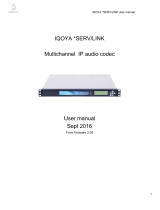 Digigram IQOYA *SERV/LINK Manuel utilisateur
Digigram IQOYA *SERV/LINK Manuel utilisateur
-
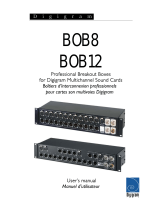 Digigram BOB8 Manuel utilisateur
Digigram BOB8 Manuel utilisateur
-
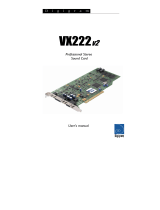 Digigram VX222v2 Manuel utilisateur
Digigram VX222v2 Manuel utilisateur
-
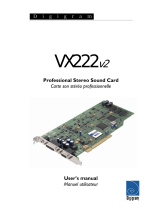 Digigram VX222v2 Manuel utilisateur
Digigram VX222v2 Manuel utilisateur
-
Digigram IGTES8AESV2 Manuel utilisateur
-
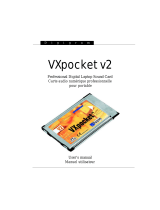 Digigram VXpocket v2 Manuel utilisateur
Digigram VXpocket v2 Manuel utilisateur
-
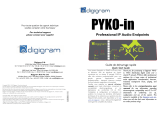 Digigram PYKO-in Guide de démarrage rapide
Digigram PYKO-in Guide de démarrage rapide
-
 Digigram PYKO-in Guide de démarrage rapide
Digigram PYKO-in Guide de démarrage rapide
-
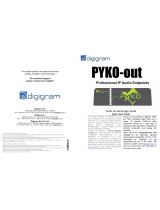 Digigram PYKO-out Guide de démarrage rapide
Digigram PYKO-out Guide de démarrage rapide
Autres documents
-
Yamaha V3 Mode d'emploi
-
Yamaha v4 Mode d'emploi
-
Yamaha AIC128 Le manuel du propriétaire
-
Tascam AE-4D Le manuel du propriétaire
-
Focusrite Pro ISA 428 MkII Mode d'emploi
-
BluStream DA11ABL-WP-EU Mode d'emploi
-
Analog way Dante audio expansion card Fiche technique
-
Yamaha v4 Manuel utilisateur
-
Cervis SmaRT EBU-9H24XF-INT-AV4-AO2 Manuel utilisateur
-
Yamaha V5 Manuel utilisateur






























































